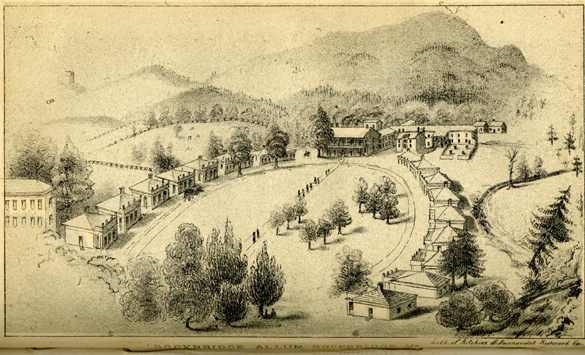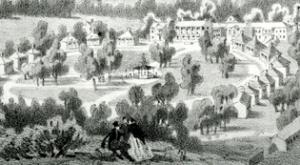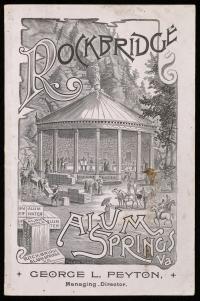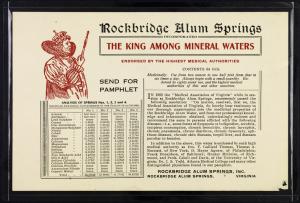Rockbridge Alum Springs
Rockbridge County, Virginia
This water I consider is the water of waters. This place is more crowded than any other in the mountains, and I have not heard of a single person who is dissatisfied. General Thomas (Stonewall) Jackson

This print shows the house and supplemental cabins that William Burke mentions in his book. {1}
William Burke on the Rockbridge Alum Springs.
The Rockbridge Alum Springs are located in Rockbridge County, Virginia, in a narrow valley about 17 miles from Lexington and 20 miles from Warm Springs. A steep road led to 15 acres of cleared land which provided the setting for a two-story frame house with a dining room, parlor, dancing hall, and several rooms for guests. This building was supplemented at both ends by six two-room cabins. The establishment was owned by the Campbell family at the time when Burke wrote his book and accommodated 80 people who were given “plain” and “indifferently served” mountain cooking of such scanty proportions that a “moderate eater can dispose of the whole in one morsel.” Burke wrote, “The private cook of a plain farmer in the mountains of Virginia cannot be supposed competent to cook for 100 persons, who have been accustomed to neat and comfortable living,” and he suggests more care in serving the guests because No matter how good the meat may be, nor how well cooked, if you cut it as you would for a dog, you get no credit for its quality; indeed, we noticed this to be a very general fault at the Springs we visited. {Burke, 372} Burke predicted that the enterprise would never be much more extensive than at the time he wrote given the difficulty of travel and of supplying the narrow valley.
Burke’s Recommendations for Using the Waters at Rockbridge Alum Springs.
Three basins, inaptly named springs in Burke’s opinion, collected water that worked its way up from crevices in rocks at the base of the mountain. Scanty in dry weather, the supply of water was greatest in rainy conditions when the rain also apparently acted as a solvent on the minerals in the rock. According to Dr. Burke, the springs had not been analyzed, but he said the water contained alum, copper and supposedly magnesia. A claim was made that it cured scrofula, a term used for tuberculosis of the lymph nodes of the neck. He could not confirm this but seemed to think it was worthy of trial and suggested that the water might also be a good treatment for lesions of the skin and some types of diarrhea. Generally unimpressed, he wrote, we should consider it as the water least capable of being profitably employed in any variety of diseases, of all the waters in the mountains. Here we found persons who were drinking twenty or more glasses a day of an agent confessedly very powerful for good or for evil. Surely this is an abuse, and can result in no advantage.{Burke, 371}
Medical Association of Virginia Endorses Rockbridge Alum Springs Mineral Water in 1883.
By a unanimous motion, the Medical Association of Virginia endorsed after “thorough examination” and with “professional knowledge” the Rockbridge Alum Springs mineral water for people afflicted with some forms of dyspepsia or indigestion, scrofula, incipient consumption, torpid liver, aphthous diseases, diseases peculiar to females, and chronic forms of bronchitis, laryngitis, pneumonia, diarrhea, chronic skin diseases, and dysentery. University of Virginia professors James L. Cabell and John S. Davis were among the medical authorities giving the endorsement.
General Thomas (Stonewall) Jackson Writes from the Alum Springs to His Sister.

Rockbridge Alum from Dr. Moorman’s 1859 book, The Virginia Springs of the South and West. This portion of a lithograph shows the pavilion not evident in the image in Dr. Moorman’s book published two years earlier. {5}
July 12, 1852: I arrived here yesterday in as good health as usual, and am delighted with the waters so far. The place is crowded, there being about four hundred visitors, and the accommodations being only adequate for two hundred and seventy-five or three hundred. I succeeded in procuring half a bed, there being one room for four occupants. In a few days I hope to be better off. Though we have had but two beds to four persons in my quarters, yet the beds are good, and the servants and proprietors and their assistants are attentive. Boarding is ten dollars per week. This water I consider is the water of waters. This place is more crowded than any other in the mountains, and I have not heard of a single person who is dissatisfied, though my inquiries have been many. My appetite and digestion have already improved, and I indulge rather freely. My dinner was principally bread, which was rather fresh, potatoes and green corn, which is by no means digestible; my supper rich corn bread, and the same for breakfast, using butter freely at each meal. {Arnold, 187}
October 1852: Jackson wrote his sister again and gave the springs credit for his improved health and indicated that he was still using the water, “but its effects are not so good as when used at the Springs.” {Arnold, 191}
Documents from the Small Special Collections Library, University of Virginia:
- Alum Springs engraving by Henry Howe, 1947: Alum Springs is one of over 100 engravings in the book Historical Collections of Virginia.
- Letter from R. L. Doyle, 1853: Doyle is anxious to secure a loan for property near the Rockbridge Alum Springs.
- Letter from Burl Fretwell, 1854: Fretwell writes that Elizabeth and the baby feel better after a visit to the springs.
- The Rockbridge Alum resort as drawn by Porte Crayon, 1857: The resort is one of many illustrations in the book Virginia Illustrated.
- Plan of Buildings at Rockbridge Alum Springs, 1869: This plan shows the locations and floor plans of various buildings at Rockbridge.
- State of Virginia First Mortgage Bond, The Rockbridge Alum Springs Company, 1880: The $500 bond is part of an issue of $22,000.
- Letter from Randolph Harrison, September 1885: Harrison writes his brother that he is on his way to Rockbridge after being sent there by [Dr.] Crenshaw.
- Letter from Randolph Harrison, October 1885: Fearful of being sick and stranded as the end of the season approaches, Harrison makes a “rapid retreat” from the springs.
- The Rockbridge Grand Hotel, 1891: The illustration highlights the bustling activity at the springs.
- Supper menu, 1899: The menu features whortleberries, stewed prunes, tenderloin steak, lamb, baked potatoes.
Additional Information:
- National Register of Historic Places Registration Form: This detailed form for Rockbridge Alum Springs is dated December 14, 1988. It includes the history and significance of the springs, descriptions of 38 buildings and ruins (including those from the Jordan Alum Springs which merged with Rockbridge in the late nineteenth century), one map, and a bibliography.
- National Register of Historic Places: The National Register has a brief summary of places in Rockbridge County, Virginia.
- Young Life Camp: Young Life is the current owner of Rockbridge Alum Springs.
Image Credits:
- {1} John J. Moorman,The Virginia Springs, Richmond, Virginia: J.W. Randolph, 1857: facing page [214]. Historical Collections & Services, Claude Moore Health Sciences Library, University of Virginia.
- {2} Merritt T. Cooke Memorial Virginia Print Collection, 1857-1907, Accession #9408, Special Collections, University of Virginia Library.
- {3} Rockbridge Alum Springs, Announcement for 1891. Its Attractions As a Summer Resort. Testimonials, Richmond, Va.: E. Waddey Co., 1891. Special Collections, University of Virginia Library.
- {4} Rockbridge Alum Springs, Incorporated: the King among Mineral Waters ; Endorsed by the Highest Medical Authorities, [Rockbridge County, Va. : s.n., between 1883 and 1900.] Special Collections, University of Virginia Library.
- {5}John J. Moorman, The Virginia Springs of the South and West, Philadelphia: J. B. Lippincott, 1859: facing page 264. Historical Collections & Services, Claude Moore Health Sciences Library, University of Virginia.
Sources:
- Thomas Jackson Arnold, Early Life and Letters of General Thomas J. Jackson, New York: Fleming H. Revell, 1916. Accessed December 3, 2008. Google Book Search.
- William Burke, The Mineral Springs of Western Virginia, New York: Wiley and Putnam, 1846.
-300x180.jpg)

